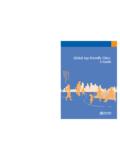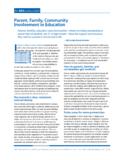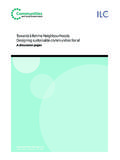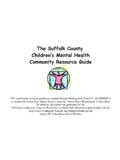Transcription of AFC Vancouver protocol - WHO
1 WHO AGE- friendly CITIES PROJECT METHODOLOGY Vancouver protocol 1 TABLE OF CONTENTS Introduction I Overall Project Objectives and Workplan Core definitions and parameters Workplan Roles and Responsibilities II Focus Group community Assessment Methodology community Profile Focus Groups with Older Persons and Caregivers Focus Groups with Service Providers III Focus Group Procedure Guide Organization Focus Group Questionnaire Data analysis and reporting Results Summary Sheet Annex 1. Informed consent form Annex 2 Discussion Questions to give in advance to Focus Group Participants Annex 3 Participant Information form World Health Organization 2007 All rights reserved. Publications of the World Health Organization can be obtained from WHO Press, World Health Organization, 20 Avenue Appia, 1211 Geneva 27, Switzerland (tel.: +41 22 791 3264; fax: +41 22 791 4857; e-mail: Requests for permission to reproduce or translate WHO publications whether for sale or for noncommercial distribution should be addressed to WHO Press, at the above address (fax: +41 22 791 4806; e-mail: The designations employed and the presentation of the material in this publication do not imply the expression of any opinion whatsoever on the part of the World Health Organization concerning the legal status of any country, territory, city or area or of its authorities, or concerning the delimitation of its frontiers or boundaries.))
2 Dotted lines on maps represent approximate border lines for which there may not yet be full agreement. The mention of specific companies or of certain manufacturers products does not imply that they are endorsed or recommended by the World Health Organization in preference to others of a similar nature that are not mentioned. Errors and omissions excepted, the names of proprietary products are distinguished by initial capital letters. All reasonable precautions have been taken by the World Health Organization to verify the information contained in this publication. However, the published material is being distributed without warranty of any kind, either expressed or implied. The responsibility for the interpretation and use of the material lies with the reader. In no event shall the World Health Organization be liable for damages arising from its use. 2 INTRODUCTION This research protocol was used by collaborating cities in conducting the focus group research in 33 cities in all world regions that led to the WHO Global Age- friendly Cities Guide in 2007.
3 It is called the Vancouver protocol in recognition of the generous support of the Government of British Columbia in hosting the meeting of project partners to prepare the protocol . The purpose of this document is to guide groups who wish to use the same research approach to assess their community 's age-friendliness as a basis to identify areas for action. The results of this local assessment can be compared with the checklists of age- friendly city features found in the WHO Global Age- friendly Cities Guide. The local information provided by older persons and others will help to pinpoint the community 's specific advantages and weak spots. Furthermore, the involvement of community members as active participants in the evaluation will elicit their support and engagement. Persons involved in Age- friendly community research process should also play a role in suggesting changes and in implementing and monitoring improvements. 3 I OVERALL PROJECT OBJECTIVES AND WORKPLAN Core definitions and parameters The project rests on the premise that an age friendly city promotes active ageing.
4 Active ageing is "the process of optimizing opportunities for optimizing opportunities for health, participation and security in order to enhance quality of life as people age" (Active Ageing: A Policy Framework, WHO, 2002). An age friendly city: recognizes the great diversity among older persons promotes their inclusion and contribution in all areas of community life respects their decisions and lifestyle choices, and anticipates and responds flexibly to aging-related needs and preferences. In an age- friendly community , there is a culture of inclusion shared by persons of all ages and ability levels. Policies, services and structures related to the physical and social environment are designed to support and enable older people to "age actively", that is, to live in security, enjoy good health and continue to participate fully in society. Focus on Cities Cities are the hub of human activity and progress. In the developed world, three-quarters of older persons live in cities already.
5 In developing countries, the convergence of rapid demographic ageing and rapid urbanization makes it critical to design cities to support and enable the massive increase of older residents. Making cities age- friendly is one of the most effective policy approaches for responding to demographic ageing. Major urban centres have the human, economic and social resources to make innovative age- friendly changes. Cities also are poles of attraction and trend-setters for their countries, and sometimes for the world. Focus on Specific eighbourhoods or Districts within Cities Within larger urban agglomerations, residents typically live, contribute, socialize, play, and obtain goods and services in smaller and often very distinct neighbourhoods or districts which are commonly known, if not administratively defined. The project will be take place in a clearly identified neighbourhood or district within large cities: for example, the project in Rio de Janeiro will be undertaken in Copacabana.
6 4 Projects in smaller cities and towns may encompass the whole community if this is more appropriate. Bottom up Participatory Approach The Age- friendly City project explicitly adopts a locally-driven and "bottom-up" approach that starts with the lived experience of older persons regarding what is, and what is not, age- friendly , and what could be done to improve their community 's age-friendliness. The knowledge and experience of public, voluntary and commercial service providers in the local community is then combined with the information from older persons to provide a more complete picture of the community 's strong points and barriers in regard to age-friendliness. This local assessment is communicated by project leaders to the public, older persons and decision-makers as the starting point for actions to make the community more age- friendly . Qualitative Research The research function entails directing the qualitative research activities involved in the project to ensure that the research process meets scientific and ethical standards and that the findings are rigorously analysed and thoroughly reported.
7 The person conducting the research must have experience in focus group methodology, and in qualitative data analysis. He or she should also have knowledge in gerontology. The research responsibility involves the following activities: implementation of the overall focus group research strategy, including ethical approval and informed consent procedures, sampling, selection, recruitment, interview, data transcription, data analysis and report preparation selection and training of research assistants reporting the research findings back to the focus group participants. 5II FOCUS GROUP community ASSESSMENT METHODOLOGY This section describes the methodology for assessing how age- friendly a neighbourhood or district is and what are the issues and barriers that will require community action. This work will a profile of the local community and a series of focus groups with older persons, caregivers of older persons and local service providers.
8 community profile It is important to present the geographic, demographic, social and economic characteristics of the city and district where the age- friendly cities project is undertaken. This information provides a context to understand the local age- friendly issues and challenges. Most of the information can be gathered from survey or administrative data. Included will be data on: location, size and topography of the district number and density of residents social, ethnic and economic characteristics numbers and proportion of older persons (60-74 and 75+) housing type and tenure distribution of public, commercial and voluntary services Focus Groups With Older Persons And Caregivers Sampling: selection, recruitment and screening A minimum set of five (5) focus groups should be conducted, four (4) of which would be with older persons and one (1) with informal caregivers of older persons who are moderately or severely disabled.
9 If local resources and time permit, more sets of focus groups are desirable to have a more extensive assessment of the community 's age-friendliness.. If a decision is made to have more than the minimum number of focus groups of older persons, it is important to ensure that all relevant characteristics are repeated to ensure a balanced representation of older persons in the total sample. Thus, two (2) sets of older persons' focus groups would mean a total of eight (2 x 4) focus groups, or three (3) sets would be 12 (3 x 4) focus groups. Increasing the focus group of caregivers beyond one would also be desirable if resources permit. Each focus group will consist of about 8 -10 people. Efforts should be made to recruit participants from a variety of sources. About 12-15 people should be invited to each group to allow for no-shows. Volunteers can be encouraged to "bring along another older 6family member or friend" to the focus group session because the subject matter is not of a particularly sensitive or private nature.
10 To enhance the amount and efficiency of information provided by the focus groups persons recruited should be given a copy of the focus group questions ahead of time to prepare for the session. Groups of older persons will be separated according to 2 age groups (60-74 and 75 and over) and to socio-economic status (at least low SES and middle SES), to constitute the groups as follows: Group Age Socio economic status 1 60-74 Low 2 60-74 Middle 3 75 and over Low 4 75 and over Middle Efforts should be made to include the "oldest-old", that is, people aged 85+, in the focus groups. Each group will consist of both men and women to reflect the sex distribution in the older adult population. Although mixed gender groups is the norm, separate groups of men and women can be conducted, if preferred in the local culture. Preferably, selection by SES will be based on the SES of the neighbourhood where the participants reside, not on the income of individual participants, to avoid asking potentially intrusive questions about personal Each group should also have a mixture of persons with no disabilities, mild disabilities and moderate disabilities, to be representative of the wide range of ability levels within the older adult population.















